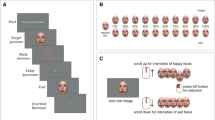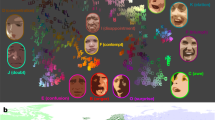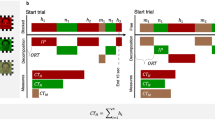Abstract
Following theories of emotional embodiment, the facial feedback hypothesis suggests that individuals’ subjective experiences of emotion are influenced by their facial expressions. However, evidence for this hypothesis has been mixed. We thus formed a global adversarial collaboration and carried out a preregistered, multicentre study designed to specify and test the conditions that should most reliably produce facial feedback effects. Data from n = 3,878 participants spanning 19 countries indicated that a facial mimicry and voluntary facial action task could both amplify and initiate feelings of happiness. However, evidence of facial feedback effects was less conclusive when facial feedback was manipulated unobtrusively via a pen-in-mouth task.
This is a preview of subscription content, access via your institution
Access options
Access Nature and 54 other Nature Portfolio journals
Get Nature+, our best-value online-access subscription
$32.99 / 30 days
cancel any time
Subscribe to this journal
Receive 12 digital issues and online access to articles
$119.00 per year
only $9.92 per issue
Buy this article
- Purchase on SpringerLink
- Instant access to full article PDF
Prices may be subject to local taxes which are calculated during checkout



Similar content being viewed by others
Data availability
The full data are publicly available at https://osf.io/ac3t2/. Source data are provided with this paper.
Code availability
The full analysis code is publicly available at https://osf.io/ac3t2/.
References
Zajonc, R. B. The primacy of affect. Am. Psychol. 40, 849–850 (1985).
Tomkins, S. Affect Imagery Consciousness: The Positive Affects Vol. 1 (Springer, 1962).
Laird, J. D. & Crosby, M. in Thought and Feeling: Cognitive Alteration of Feeling States (eds London, H. & Nisbett, R. E.) 44–59 (Transaction, 1974).
Allport, F. H. A physiological–genetic theory of feeling and emotion. Psychol. Rev. 29, 132–139 (1922).
Levenson, R. W., Ekman, P. & Friesen, W. V. Voluntary facial action generates emotion-specific autonomic nervous system activity. Psychophysiology 27, 363–384 (1990).
Coan, J. A., Allen, J. J. B. & Harmon-Jones, E. Voluntary facial expression and hemispheric asymmetry over the frontal cortex. Psychophysiology 38, 912–925 (2001).
Scherer, K. R. & Moors, A. The emotion process: event appraisal and component differentiation. Annu. Rev. Psychol. 70, 719–745 (2019).
Stepper, S. & Strack, F. Proprioceptive determinants of emotional and nonemotional feelings. J. Pers. Soc. Psychol. 64, 211–220 (1993).
Friedman, B. H. Feelings and the body: the Jamesian perspective on autonomic specificity of emotion. Biol. Psychol. 84, 383–393 (2010).
James, W. Discussion: the physical basis of emotion. Psychol. Rev. 1, 516–529 (1894).
Lange, C. G. Om Sindsbevaegelser; Et Psyko-Fysiologisk Studie (Lund, 1885).
Cannon, W. The James–Lange theory of emotions: a critical examination and an alternative theory. Am. J. Psychol. 39, 106–124 (1927).
Cannon, W. Bodily Changes in Pain, Hunger, Fear and Rage (D. Appleton, 1915).
Sherrington, C. S. Experiments on the value of vascular and visceral factors for the genesis of emotion. Proc. R. Soc. Lond. 66, 390–403 (1899).
Ansfield, M. E. Smiling when distressed: when a smile is a frown turned upside down. Pers. Soc. Psychol. Bull. 33, 763–775 (2007).
Kraft, T. L. & Pressman, S. D. Grin and bear it: the influence of manipulated facial expression on the stress response. Psychol. Sci. 23, 1372–1378 (2012).
Schmitz, B. Art-of-Living: A Concept to Enhance Happiness (Springer Cham, 2016).
Lyubomirsky, S. The How of Happiness: A Scientific Approach to Getting the Life You Want (Penguin Group, 2008).
Alam, M., Barrett, K. C., Hodapp, R. M. & Arndt, K. A. Botulinum toxin and the facial feedback hypothesis: can looking better make you feel happier? J. Am. Acad. Dermatol. 58, 1061–1072 (2008).
Alves, M. C., Sobreira, G., Aleixo, M. A. & Oliveira, J. M. Facing depression with botulinum toxin: literature review. Eur. Psychiatry 335, 5290–5643 (2016).
Chugh, S., Chhabria, A., Jung, S., Kruger, T. H. C. & Wollmer, M. A. Botulinum toxin as a treatment for depression in a real-world setting. J. Psychiatr. Pract. 24, 15–20 (2018).
Finzi, E. Update: botulinum toxin for depression: more than skin deep. Dermatol. Surg. 44, 1363–1365 (2018).
Finzi, E. & Rosenthal, N. E. Emotional proprioception: treatment of depression with afferent facial feedback. J. Psychiatr. Res. 80, 93–96 (2016).
Finzi, E. & Rosenthal, N. E. Treatment of depression with onabotulinumtoxinA: a randomized, double-blind, placebo controlled trial. J. Psychiatr. Res. 52, 1–6 (2014).
Finzi, E. & Wasserman, E. Treatment of depression with botulinum toxin A: a case series. Dermatol. Surg. 32, 645–649 (2006).
Fromage, G. Exploring the effects of botulinum toxin type A injections on depression. Aesthet. Nurs. 7, 315–317 (2018).
Hexsel, D. et al. Evaluation of self-esteem and depression symptoms in depressed and nondepressed subjects treated with onabotulinumtoxinA for glabellar lines. Dermatol. Surg. 39, 1088–1096 (2013).
Krüger, T. H. C., Jung, S. & Wollmer, M. A. Botulinumtoxin—ein neuer wirkstoff in der psychopharmakotherapie? Psychopharmakotherapie 23, 2–7 (2016).
Lewis, M. B. & Bowler, P. J. Botulinum toxin cosmetic therapy correlates with a more positive mood. J. Cosmet. Dermatol. 8, 24–26 (2009).
Magid, M. et al. Treating depression with botulinum toxin: a pooled analysis of randomized controlled trials. Pharmacopsychiatry 48, 205–210 (2015).
Magid, M. & Reichenberg, J. S. Botulinum toxin for depression? An idea that’s raising some eyebrows. Curr. Psychiatr. 14, 43–56 (2015).
Magid, M. et al. Treatment of major depressive disorder using botulinum toxin A: a 24-week randomized, double-blind, placebo-controlled study. J. Clin. Psychiatry 75, 837–844 (2014).
Parsaik, A. K. et al. Role of botulinum toxin in depression. J. Psychiatr. Pract. 22, 99–110 (2016).
Reichenberg, J. S. et al. Botulinum toxin for depression: does patient appearance matter? J. Am. Acad. Dermatol. 74, 171–173 (2016).
Wollmer, M. A., Magid, M. & Kruger, T. H. C. in Practical Psychodermatology (eds Bewley, A. et al.) 216–219 (John Wiley & Sons, 2014).
Wollmer, M. A. et al. Agitation predicts response of depression to botulinum toxin treatment in a randomized controlled trial. Front. Psychiatry 5, 36 (2014).
Wollmer, M. A. et al. Facing depression with botulinum toxin: a randomized controlled trial. J. Psychiatr. Res. 46, 574–581 (2012).
Zamanian, A., Jolfaei, A. G., Mehran, G. & Azizian, Z. Efficacy of Botox versus placebo for treatment of patients with major depression. Iran. J. Public Health 46, 982–984 (2017).
Finzi, E. The Face of Emotion: How Botox Affects Our Moods and Relationships (St. Martin’s, 2013).
Wagenmakers, E.-J. et al. Registered replication report: Strack, Martin, & Stepper (1988). Perspect. Psychol. Sci. 11, 917–928 (2016).
Strack, F., Martin, L. L. & Stepper, S. Inhibiting and facilitating conditions of the human smile: a nonobtrusive test of the facial feedback hypothesis. J. Pers. Soc. Psychol. 54, 768–777 (1988).
Buck, R. Nonverbal behavior and the theory of emotion: the facial feedback hypothesis. J. Pers. Soc. Psychol. 38, 811–824 (1980).
Zuckerman, M., Klorman, R., Larrance, D. T. & Spiegel, N. H. Facial, autonomic, and subjective components of emotion: the facial feedback hypothesis versus externalizer–internalizer distinction. J. Pers. Soc. Psychol. 41, 929–944 (1981).
Ekman, P. & Oster, H. Facial expressions of emotion. Annu. Rev. Psychol. 30, 527–554 (1979).
Laird, J. D. Self-attribution of emotion: the effects of expressive behavior on the quality of emotional experience. J. Pers. Soc. Psychol. 29, 475–486 (1974).
Laird, J. D. & Bresler, C. in Review of Personality and Social Psychology: Emotion (ed. Clark, M. S.) 213–234 (Sage, 1992).
Ekman, P. in Anthropology of the Body (ed. Blacking, J.) 34–38 (Routledge, 1979).
Schimmack, U. & Chen, Y. The power of the pen paradigm: a replicability analysis. Replicability-Index https://replicationindex.com/2017/09/04/the-power-of-the-pen-paradigm-a-replicability-analysis/ (2017).
Strack, F. Reflection on the Smiling Registered Replication Report. Perspect. Psychol. Sci. 11, 929–930 (2016).
Noah, T., Schul, Y. & Mayo, R. When both the original study and its failed replication are correct: feeling observed eliminates the facial-feedback effect. J. Pers. Soc. Psychol. 114, 657–664 (2018).
Hager, J. C. & Ekman, P. Methodological problems in Tourangeau and Ellsworth’s study of facial expression and experience of emotion. J. Pers. Soc. Psychol. 40, 358–362 (1981).
Tomkins, S. The role of facial response in the experience of emotion: a reply to Tourangeau and Ellsworth. J. Pers. Soc. Psychol. 37, 1519–1531 (1981).
Matsumoto, D. The role of facial response in the experience of emotion: more methodological problems and a meta-analysis. J. Pers. Soc. Psychol. 52, 769–774 (1987).
Levenson, R. W., Ekman, P., Heider, K. & Friesen, W. V. Emotion and autonomic nervous system activity in the Minangkabau of West Sumatra. J. Pers. Soc. Psychol. 62, 972–988 (1992).
Ekman, P. Facial expression and emotion. Am. Psychol. 48, 384–392 (1993).
Soussignan, R. Duchenne smile, emotional experience, and autonomic reactivity: a test of the facial feedback hypothesis. Emotion 2, 52–74 (2002).
Lambie, J. A. & Marcel, A. J. Consciousness and the varieties of emotion experience: a theoretical framework. Psychol. Rev. 109, 219–259 (2002).
Frijda, N. H. Emotion experience. Cogn. Emot. 194, 473–497 (2010).
Coles, N. A., Larsen, J. T. & Lench, H. C. A meta-analysis of the facial feedback literature: effects of facial feedback on emotional experience are small and variable. Psychol. Bull. 145, 610–651 (2019).
Carter, E. C., Schönbrodt, F. D., Gervais, W. M. & Hilgard, J. Correcting for bias in psychology: a comparison of meta-analytic methods. Adv. Methods Pract. Psychol. Sci. 2, 115–144 (2019).
Macaskill, P., Walter, S. D. & Irwig, L. A comparison of methods to detect publication bias in meta-analysis. Stat. Med. 20, 641–654 (2001).
Stanley, T. D. Limitations of PET-PEESE and other meta-analysis methods. Soc. Psychol. Pers. Sci. 8, 581–591 (2017).
Eysenck, H. J. An exercise in mega-silliness. Am. Psychol. 33, 517 (1978).
Kleinke, C. L., Peterson, T. R. & Rutledge, T. R. Effects of self-generated facial expressions on mood. J. Pers. Soc. Psychol. 74, 272–279 (1998).
Dimberg, U. & Söderkvist, S. The voluntary facial action technique: a method to test the facial feedback hypothesis. J. Nonverbal Behav. 35, 17–33 (2011).
R Core Team. R: A Language and Environment for Statistical Computing v.4.1.2 https://www.Rproject.org/ (R Foundation for Statistical Computing, 2021).
Bates, D., Mächler, M., Bolker, B. & Walker, S. Fitting linear mixed-effects models using lme4: mixed-effects modeling with R. J. Stat. Softw. 67, 1–48 (2015).
Kuznetsova, A., Brockhoff, P. B. & Christensen, R. H. B. lmerTest package: tests in linear mixed effects models. J. Stat. Softw. 82, 1–26 (2017).
Lenth, R. V. emmeans: Estimated marginal means, aka least-squares means. R package version 1.7.2 (2022).
Morey, R. D. & Rouder, J. N. BayesFactor: Computation of Bayes factors for common designs. R package version 0.9.12-4.3 (2021).
Wilson, T. D. et al. Just think: the challenges of the disengaged mind. Science 345, 75–77 (2014).
Brown, V. A. An introduction to linear mixed-effects modeling in R. Adv. Methods Pract. Psychol. Sci. 4, 1–19 (2021).
Coles, N. A., Gaertner, L., Frohlich, B., Larsen, J. T. & Basnight-Brown, D. Fact or artifact? Methodological artifacts moderate, but do not fully account for, the effects of facial feedback on emotional experience. J. Pers. Soc. Psychol. 1–24 (2022).
Izard, C. E. The Face of Emotion (Appleton-Century-Crofts, 1971).
James, W. What is an emotion? Mind 9, 188–205 (1884).
Laird, J. D. & Lacasse, K. Bodily influences on emotional feelings: accumulating evidence and extensions of William James’s theory of emotion. Emot. Rev. 6, 27–34 (2014).
Funder, D. C. & Ozer, D. J. Evaluating effect size in psychological research: sense and nonsense. Adv. Methods Pract. Psychol. Sci. 2, 156–168 (2019).
Ekman, P. & Rosenberg, E. L. What the Face Reveals: Basic and Applied Studies of Spontaneous Expression Using the Facial Action Coding System (FACS) (Oxford Univ. Press, 1997).
Larsen, J. T., Norris, C. J. & Cacioppo, J. T. Effects of positive and negative affect on electromyographic activity over zygomaticus major and corrugator supercilii. Psychophysiology 40, 776–785 (2003).
Alfen, N. Van, Gilhuis, H. J., Keijzers, J. P., Pillen, S. & Van Dijk, J. P. Quantitative facial muscle ultrasound: feasibility and reproducibility. Muscle Nerve 48, 375–380 (2013).
Clay-Warner, J. & Robinson, D. T. Infrared thermography as a measure of emotion response. Emot. Rev. 7, 157–162 (2014).
Harmon-Jones, C., Bastian, B. & Harmon-Jones, E. The Discrete Emotions Questionnaire: a new tool for measuring state self-reported emotions. PLoS ONE 11, e0159915 (2016).
Ekman, P. Darwin, deception, and facial expression. Ann. N. Y. Acad. Sci. 1000, 205–221 (2003).
Shields, S. A., Mallory, M. E. & Simon, A. The body awareness questionnaire: reliability and validity. J. Pers. Assess. 53, 802–815 (1989).
Marsh, A. A., Rhoads, S. A. & Ryan, R. M. A multi-semester classroom demonstration yields evidence in support of the facial feedback effect. Emotion 19, 1500–1504 (2019).
Lucey, P. et al. The Extended Cohn–Kanade Dataset (CK+): a complete dataset for action unit and emotion-specified expression. In Proc. IEEE Comput. Soc. Conf. Comput. Vis. Pattern Recognit. 94–101 (IEEE, 2010).
Lang, P. & Bradley, M. M. in Handbook of Emotion Elicitation and Assessment (eds Coan, J. A. & Allen, J. J. B.) 29–46 (Oxford Univ. Press, 2007).
March, D. S., Gaertner, L. & Olson, M. A. In harm’s way: on preferential response to threatening stimuli. Pers. Soc. Psychol. Bull. 43, 1519–1529 (2017).
Klein, R. A. et al. Many Labs 2: investigating variation in replicability across samples and settings. Adv. Methods Pract. Psychol. Sci. 1, 443–490 (2018).
Acknowledgements
This work was financially supported by B. Stastny, who generously donated funds for this research in memory of his father, Bill Stastny (J.T.L.). The work was also supported by the National Science Centre, Poland (grant no. 2019/35/B/HS6/00528; K.B.), JSPS KAKENHI (grant nos 16H03079, 17H00875, 18K12015, 20H04581 and 21H03784; Y.Y.), the National Council for Scientific and Technological Development (CNPq; R.M.K.F.), the Polish National Science Center (M.P.), the DFG Beethoven grant no. 2016/23/G/HS6/01775 (M.P.), the National Science Foundation Graduate Research Fellowship (grant no. R010138018; N.A.C.), the Ministerio de Ciencia, Innovación y Universidades (grant no. PGC2018-098558-B-I00; J.A.H.), the Comunidad de Madrid (grant no. H2019/HUM-5705; J.A.H.), Teesside University (N.B.) and the Occidental College Academic Student Project Award (S.L.). The funders had no role in study design, data collection and analysis, decision to publish or preparation of the manuscript. We also thank C. Scavo and A. Bidani for help with translating the study materials, L. Pullano and R. Giorgini for help with coding, and E. Tolomeo and L. Pane for help with data collection.
Author information
Authors and Affiliations
Contributions
Conceptualization: N.A.C., D.S.M., F.M.-R., J.T.L., J.F.H., P.M.G., P.C.E., L.G. and F.S. Data curation: N.A.C., B.S., Y.Y. and S.R.-F. Formal analysis: N.A.C., L.G., M.M. and M.T.L. Funding acquisition: N.A.C., Y.Y. and N.B. Investigation: N.A.C., D.S.M., J.T.L., N.C.A., I.L.G.N., M.L.W., F.F., N.R., A.M., J.F.H., G.K., E.Y., A.K., N.H., J.T., R.M.K.F., D.Z., B.A., K.B., S.A., K.F., Y.Y., A.I., D.L.E., C.A.L., S.L., M.P., N.B., G.P., D.M.B.-B., J.A.H., P.R.M., L.G.J.D., K.V., H.IJ., N.T., S.D.P., P.M.G., A.A.Ö., S.R.-F. and M.T.L. Methodology: N.A.C., D.S.M., F.M.-R., P.S.F., J.F.H., G.K., K.B., D.L.E., S.R.-F., P.C.E. and L.G. Project administration: N.A.C., M.L.W., F.F., P.S.F., J.F.H., J.T., K.B., K.F., D.L.E., M.P., H.IJ., S.D.P. and A.A.Ö. Resources: N.A.C., D.S.M., I.L.G.N., E.Y., A.K., T.N., R.M.K.F., B.A., K.B., S.A., M.P., G.P., J.A.H., P.R.M., H.IJ., P.M.G., A.A.Ö. and S.R.-F. Software: N.A.C., J.T. and M.M. Supervision: N.A.C., N.C.A., F.F., N.R., J.F.H., B.A., K.B., C.A.L., N.B., H.IJ. and S.D.P. Validation: N.A.C., P.S.F., N.H., J.T., M.P., N.T., M.M. and M.T.L. Visualization: N.A.C., P.S.F., J.A.H. and L.G. Writing—original draft: N.A.C., D.S.M., A.A.Ö. and L.G. Writing—review and editing: N.A.C., D.S.M., F.M.-R., J.T.L., N.C.A., I.L.G.N., M.L.W., F.F., N.R., A.M., P.S.F., J.F.H., G.K., T.N., N.H., D.Z., B.A., K.B., Y.Y., D.L.E., N.B., G.P., D.M.B.-B., J.A.H., P.R.M., L.G.J.D., H.IJ., N.T., S.D.P., P.M.G., A.A.Ö., S.R.-F., P.C.E., L.G., F.S., M.M. and M.T.L.
Corresponding author
Ethics declarations
Competing interests
The authors declare no competing interests.
Peer review
Peer review information
Nature Human Behaviour thanks David Mellor, Rainer Reisenzein, Jared McGinley and Quentin Gronau for their contribution to the peer review of this work.
Supplementary information
Supplementary Information
Supplementary Figs. 1–3, results from pilot studies 1–3, and results and discussion from the main study.
Source data
Source Data Fig. 1
Data on country-specific sample sizes.
Source Data Fig. 2
Participant-level data for the primary analyses.
Source Data Fig. 3
Participant-level data for the secondary moderator analyses.
Rights and permissions
Springer Nature or its licensor holds exclusive rights to this article under a publishing agreement with the author(s) or other rightsholder(s); author self-archiving of the accepted manuscript version of this article is solely governed by the terms of such publishing agreement and applicable law.
About this article
Cite this article
Coles, N.A., March, D.S., Marmolejo-Ramos, F. et al. A multi-lab test of the facial feedback hypothesis by the Many Smiles Collaboration. Nat Hum Behav 6, 1731–1742 (2022). https://doi.org/10.1038/s41562-022-01458-9
Received:
Accepted:
Published:
Issue date:
DOI: https://doi.org/10.1038/s41562-022-01458-9
This article is cited by
-
Artificial intelligence, digital social networks, and climate emotions
npj Climate Action (2025)
-
Electrical stimulation of smiling muscles reduces visual processing load and enhances happiness perception in neutral faces
Communications Psychology (2025)
-
Make science more collegial: why the time for ‘adversarial collaboration’ has come
Nature (2025)
-
The interplay of sensory and motoric information on processing emotions in narrative texts
Journal of Cultural Cognitive Science (2025)
-
Emotional contagion to vocal smile revealed by combined pupil reactivity and motor resonance
Scientific Reports (2024)



